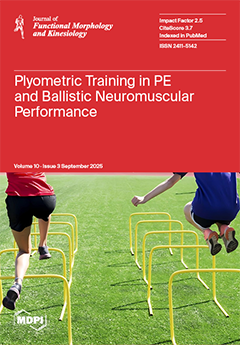Background: This study examined the impact of aerobic capacity on force–velocity (F–v) variables and repeated-sprint (RS) performance in male national-level sprinters (SPRs,
n = 8; 177.0 ± 4.3 cm; 74.0 ± 5.0 kg; maximal oxygen uptake [VO
2max]: 55.4 ± 3.0 mL/kg/min) and middle-distance runners (MDRs;
n = 8; 179.0 ± 5.1 cm; 67.2 ± 5.0 kg; VO
2max: 64.3 ± 3.3 mL/kg/min).
Method: Participants underwent assessments of aerobic capacity, mechanical F-v profiling in sprinting 2 × 60 m with full recovery, and a 10 × 60 m repeated-sprint test with 30 s recovery.
Results: MDRs exhibited significantly higher VO
2max (
p < 0.001) and speed at VO
2max (vVO
2max,
p < 0.001), while SPRs demonstrated greater anaerobic speed reserve (ASR,
p < 0.001), maximal theoretical horizontal force (F
0,
p = 0.012), and power output (P
max,
p < 0.01). During the RS test, SPRs displayed a 16.6% performance decrement (
p = 0.002) and failed to complete all sprints with voluntary withdrawal after 5–8 sprints due to exhaustion, whereas MDRs maintained consistent performance. SPRs exhibited a larger decrease in v
0 compared to MDRs (
p < 0.01), whereas no differences were observed on F
0 (
p = 0.519) and P
max (
p = 0.758). Blood lactate accumulation was higher in SPRs (
p < 0.001). Multiple linear regression analysis on the pooled sample identified vVO
2max (
p = 0.003) and not ASR (
p = 0.482) as a key predictor of fatigue resistance.
Conclusions: These findings underscore the critical role of aerobic capacity in sustaining RS performance. Aerobic capacity, specifically vVO
2max, emerged as the primary determinant of fatigue resistance during repeated sprints, underscoring its critical role in sustaining RS performance over mechanical variables such as v
0 but not F
0 and P
max.
Full article






